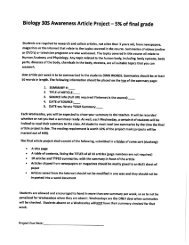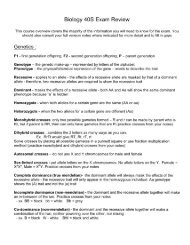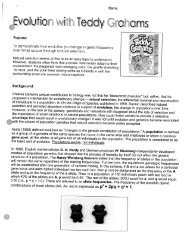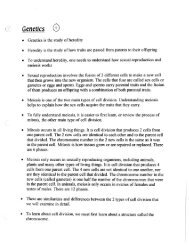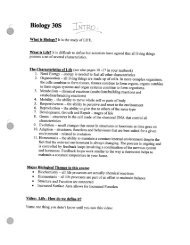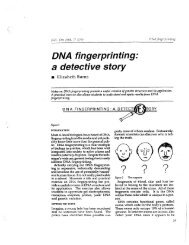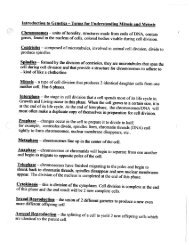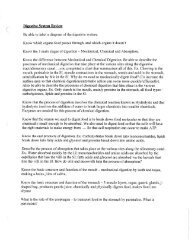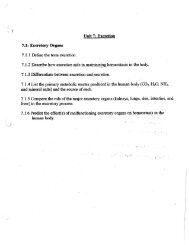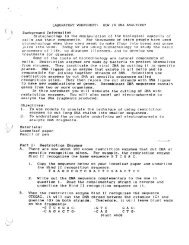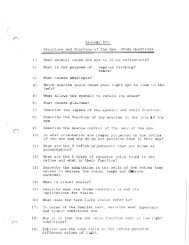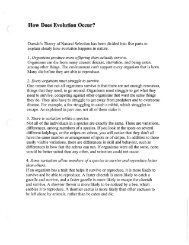The Roles of the Nephron of the 120 ml of blood that is ... - Mrs Stovel
The Roles of the Nephron of the 120 ml of blood that is ... - Mrs Stovel
The Roles of the Nephron of the 120 ml of blood that is ... - Mrs Stovel
- No tags were found...
Create successful ePaper yourself
Turn your PDF publications into a flip-book with our unique Google optimized e-Paper software.
<strong>The</strong> <strong>Roles</strong> <strong>of</strong> <strong>the</strong> <strong>Nephron</strong><strong>of</strong> <strong>the</strong> <strong>120</strong> <strong>ml</strong> <strong>of</strong> <strong>blood</strong> <strong>that</strong> <strong>is</strong> filtered by <strong>the</strong> kidneys each minute, only I <strong>ml</strong>(<strong>that</strong>'s less than I%) turns into urine <strong>that</strong> will eventually leave <strong>the</strong> body(after approximately 300 - 400 m<strong>is</strong> <strong>of</strong> it accumulates to fill <strong>the</strong> bladder!)That leaves 119 <strong>ml</strong> <strong>of</strong> fluid called filtrate to be returned back to <strong>the</strong> <strong>blood</strong>stream. Good thing, o<strong>the</strong>rw<strong>is</strong>e you would have to micturate (pee, urinate)once every 3 minutes and drink 1 L <strong>of</strong> fluid every 10 minutes in order tomaintain Homeostas<strong>is</strong>!!!<strong>The</strong> one million nephrons in each human kidney are amazingly efficient atselectively removing wastes from <strong>the</strong> <strong>blood</strong> while at <strong>the</strong> same timeconserving water, salt ions, glucose and o<strong>the</strong>r needed materials. <strong>The</strong>nephrons accompl<strong>is</strong>h th<strong>is</strong> task in 3 main steps; <strong>the</strong>se 3 steps are also called<strong>the</strong> 3 main roles <strong>of</strong> <strong>the</strong> nephron: Filtration, Reabsorption and Secretion.FiftratfflnFiltration <strong>is</strong>aecompl<strong>is</strong>hed by <strong>the</strong>movement <strong>of</strong> fluids from<strong>the</strong> <strong>blood</strong> into <strong>the</strong>Bowman's capsule.BeabsorpttortReatuorptias wolves <strong>the</strong>selective transfer <strong>of</strong>essential solutes andwater back into <strong>the</strong> <strong>blood</strong>.SecretionSecretion Involves <strong>the</strong>movement <strong>of</strong> wastes from<strong>the</strong> <strong>blood</strong> into <strong>the</strong>mphron.1. Filtration<strong>The</strong> renal artery carries <strong>blood</strong> into <strong>the</strong> kidney (approximately 600 m<strong>is</strong> <strong>of</strong><strong>blood</strong> enters a kidney each minute). <strong>The</strong> renal artery <strong>the</strong>n branches intoarterioles which <strong>the</strong>n branch intoaspecialized capillaries called <strong>the</strong>glomerulus. Because <strong>of</strong> <strong>the</strong> great difference in diameter between <strong>the</strong> renalartery and <strong>the</strong> glomerul us, <strong>blood</strong> entering <strong>the</strong> glomerulus <strong>is</strong> under very highpressure. Th<strong>is</strong> pressure forces about 20% <strong>of</strong> <strong>the</strong> <strong>blood</strong> plasma (about <strong>120</strong>m1<strong>of</strong> <strong>the</strong> 600 <strong>ml</strong>) out <strong>of</strong> <strong>the</strong> glomerulus and across <strong>the</strong> membrane <strong>of</strong> Bowman's
capsule. Bowman's capsule acts to "filter" or separate some <strong>of</strong> <strong>the</strong>substances <strong>that</strong> are located in <strong>blood</strong> plasma from o<strong>the</strong>rs. Th<strong>is</strong> <strong>is</strong> becausesome substances are small enough to fit through <strong>the</strong> pores <strong>of</strong> <strong>the</strong> membrane<strong>of</strong> Bowman's capsule and some are too large and thus do not enterBowman's capsule with <strong>the</strong> rest <strong>of</strong> <strong>the</strong> <strong>blood</strong> plasma. Water, salt ions(sodium, potassium and choride), glucose molecules, amino acids and ureamolecules are all small enough to go through <strong>the</strong> membrane pores intoBowman's capsule. Blood cells (rbc, wbc and platelets) and proteins on <strong>the</strong>o<strong>the</strong>r hand are too large to leave <strong>the</strong> capillaries or enter Bowman's capsule.<strong>The</strong> fluid inside <strong>of</strong> Bowman's capsule gets a name change; it <strong>is</strong> now called"filtrate" because it <strong>is</strong> <strong>blood</strong> plasma <strong>that</strong> has been filtered, Th<strong>is</strong> filtrate <strong>is</strong>identical to <strong>blood</strong> plasma minus <strong>the</strong> <strong>blood</strong> cells and proteins. Filtrate <strong>is</strong> saidto be <strong>is</strong>otonic to <strong>blood</strong> plasma with respect to its concentration <strong>of</strong> water, saltions, glucose, amino acids and urea. <strong>The</strong> filtrate will <strong>the</strong>n proceed fromBowman's capsule through <strong>the</strong> rest <strong>of</strong> <strong>the</strong> nephron in <strong>the</strong> following order:proximal convoluted tubule, loop <strong>of</strong> henle, d<strong>is</strong>tal convoluted tubule andfinally <strong>the</strong> collecting tubule. From <strong>the</strong> collecting tubule, <strong>the</strong> filtrate will enter<strong>the</strong> pelv<strong>is</strong> <strong>of</strong> <strong>the</strong> kidney and be called urine.2. ReabsorptionUseful materials such as sugars and salt ions are reabsorbed back into <strong>the</strong><strong>blood</strong> stream. That <strong>is</strong>, materials <strong>that</strong> could still be used by <strong>the</strong> body are sentback to <strong>the</strong> <strong>blood</strong>. Reabsorption happens as filtrate passes sequentiallythrough <strong>the</strong> nephron. Materials re-entering <strong>the</strong> <strong>blood</strong> stream do so through<strong>the</strong> capillary network surrounding <strong>the</strong> nephrons. In short, "good" stuff <strong>is</strong> sentfrom <strong>the</strong> nephron back into <strong>the</strong> <strong>blood</strong>.A. Proximal Convoluted Tubule (PCn:As <strong>the</strong> filtrate enters <strong>the</strong> PCT approximately 80% <strong>of</strong> <strong>the</strong> salt ions (sodiumand potassium), glucose and amino acids are ACTIVELYTRANSPORTED out <strong>of</strong> <strong>the</strong> PCT and back into <strong>the</strong> <strong>blood</strong> stream byspecial "pumping" cells located in <strong>the</strong> walls <strong>of</strong> <strong>the</strong> PCT. <strong>The</strong> process <strong>of</strong>active transport requires energy. Energy in <strong>the</strong> form <strong>of</strong> ATP <strong>is</strong> suppliedby <strong>the</strong> numerous mitochondria <strong>that</strong> are embedded in <strong>the</strong> walls <strong>of</strong> <strong>the</strong>PCT. Because <strong>of</strong> ionic attraction, negatively charged chloride ions (CI-)will flow passively out <strong>of</strong> <strong>the</strong> PCT as <strong>the</strong>y are attracted by <strong>the</strong> positivelycharged sodium and potassium ions (Na+, K+). As <strong>the</strong> concentration <strong>of</strong><strong>the</strong> above mentioned solute molecules drops inside <strong>of</strong> <strong>the</strong> PCT, water
<strong>the</strong>n diffuses out <strong>of</strong> <strong>the</strong> PCT and into <strong>the</strong> capillary network passively by<strong>the</strong> process <strong>of</strong> OSMOSIS. <strong>The</strong> lining <strong>of</strong> <strong>the</strong> PCT contains microvilli toincrease <strong>the</strong> surface area over which th<strong>is</strong> reabsorption can occur.B. Descending Loop <strong>of</strong> Henle:As <strong>the</strong> filtrate travels into <strong>the</strong> descending Loop <strong>of</strong> Henle, both sodiumand potassium ions passively diffuse from <strong>the</strong> salty t<strong>is</strong>sues <strong>of</strong> <strong>the</strong>surrounding medulla BACK INTO <strong>the</strong> Loop <strong>of</strong> Henle. (Although th<strong>is</strong> <strong>is</strong>reabsorption <strong>of</strong> materials, <strong>the</strong> materials are not going back into <strong>the</strong> <strong>blood</strong>stream at th<strong>is</strong> point). At <strong>the</strong> same time, water continues to move out <strong>of</strong><strong>the</strong> Loop <strong>of</strong> Henle and into <strong>the</strong> capillary network by osmos<strong>is</strong>. <strong>The</strong> filtrateat th<strong>is</strong> point <strong>is</strong> more concentrated (hypertonic) with respect to salt ionsthan it was in <strong>the</strong> PCT, both because water has been removed from it, andbecause salt ions have been again added to it.C. AscendineLoop <strong>of</strong> HenleAs <strong>the</strong> filtrate proceeds up into <strong>the</strong> ascending Loop <strong>of</strong> Henle, <strong>the</strong> chorideions are actively pumped back out <strong>of</strong> <strong>the</strong> nephron. Because <strong>of</strong> ionicattraction, sodium ions <strong>the</strong>n passively follow <strong>the</strong> chloride ions out <strong>of</strong> <strong>the</strong>tubule and into <strong>the</strong> t<strong>is</strong>sues <strong>of</strong> <strong>the</strong> medulla. <strong>The</strong>se ions only move into <strong>the</strong>medulla and not back into <strong>the</strong> <strong>blood</strong> stream. Since <strong>the</strong> ascending Loop <strong>of</strong>Henle <strong>is</strong> impermeable to water, water cannot leave th<strong>is</strong> part <strong>of</strong> <strong>the</strong>nephron. Because <strong>of</strong> th<strong>is</strong>, <strong>the</strong> filtrate gets more dilute again.Because <strong>the</strong> opposite happens in <strong>the</strong> ascending and descending Loops <strong>of</strong>Henle, <strong>the</strong> process <strong>is</strong> called <strong>the</strong> COUNTER CURRENTMECHANISM. <strong>The</strong> process <strong>is</strong> also known as <strong>the</strong> CHLORIDE SfUFT.D. D<strong>is</strong>tal Convoluted Tubule (DCT)As <strong>the</strong> filtrate passes through th<strong>is</strong> part <strong>of</strong> <strong>the</strong> nephron, water continues topassively diffuse out <strong>of</strong> <strong>the</strong> nephron and back into <strong>the</strong> <strong>blood</strong>. Watercontinues to diffuse out <strong>of</strong> <strong>the</strong> DCT because <strong>the</strong> surrounding t<strong>is</strong>sues <strong>of</strong><strong>the</strong> medulla are now very salty due to so much sodium and chloride ionsaccumulating <strong>the</strong>re. <strong>The</strong> salty t<strong>is</strong>sues attract <strong>the</strong> water out <strong>of</strong> <strong>the</strong> DCTbecause <strong>the</strong> medulla <strong>is</strong> hypertonic with respect to salt concentration whencompared with <strong>the</strong> salt concentration <strong>of</strong> <strong>the</strong> filtrate (now hypotonic).Water <strong>that</strong> enters <strong>the</strong> medulla will <strong>the</strong>n diffuse back into <strong>the</strong> <strong>blood</strong>
stream. Because <strong>of</strong> <strong>the</strong> continual re-absorption <strong>of</strong> water, <strong>the</strong> filtratebecomes more and more concentrated with wastes, mainly urea. <strong>The</strong>amount <strong>of</strong> water <strong>that</strong> diffuses can be regulated by a hormone calledADH. <strong>The</strong> amount <strong>of</strong> water <strong>that</strong> diffuses from <strong>the</strong> DCT back into <strong>the</strong><strong>blood</strong> depends on <strong>the</strong> needs <strong>of</strong> <strong>the</strong> body; if <strong>the</strong> body <strong>is</strong> dehydrated, morewater will go back into <strong>the</strong> <strong>blood</strong>, and less will be left in <strong>the</strong> nephron tomake less urine. <strong>The</strong> opposite occurs if <strong>the</strong> body <strong>is</strong> over hydrated.E. Collecting Tubule C<strong>The</strong> same thing <strong>that</strong> occurs in <strong>the</strong> DCT also occurs in <strong>the</strong> CT3. SecretionOccurring at <strong>the</strong> same time as reabsorption <strong>is</strong> a process called secretion.Secretion <strong>is</strong> when a cell releases a substance to its outside... in th<strong>is</strong> case,non-useful and toxic substances are ACTIVELY TRANSPORTED from <strong>the</strong><strong>blood</strong> into <strong>the</strong> nephron - usually in <strong>the</strong> regions <strong>of</strong> <strong>the</strong> d<strong>is</strong>tal and proximalconvoluted tubules. Substances which are secreted include excess acid (H+)or base (OH-) ions, excess glucose (high glucose levels are found in diabeticurine or urine <strong>of</strong> someone who has recently consumed a large amount <strong>of</strong>sugar-th<strong>is</strong> <strong>is</strong> <strong>the</strong> kidney's way <strong>of</strong> helping to ensure <strong>that</strong> <strong>the</strong> <strong>blood</strong> sugarlevel doesn't get too high), ammonia, and drugs (th<strong>is</strong> <strong>is</strong> why urine <strong>is</strong> usedfrom many drug tests - <strong>the</strong> breakdown <strong>of</strong> many drugs including marijuana,cocaine, heroin, sleeping pills, codeine and many o<strong>the</strong>r medications can bedetected even in minute amounts in <strong>the</strong> urine). <strong>The</strong> process <strong>of</strong> secretionensures <strong>that</strong> materials <strong>that</strong> are potentially harmful to <strong>the</strong> body are quicklyd<strong>is</strong>posed <strong>of</strong> by being "dumped" into <strong>the</strong> fluid <strong>that</strong> <strong>is</strong> about to become urine.Secretion happens mainly in <strong>the</strong> regions <strong>of</strong> <strong>the</strong> DCT and CT but some alsooccurs in <strong>the</strong> PCT. In short, secretion involves "bad" stuff being removedfrom <strong>the</strong> <strong>blood</strong> being sent to <strong>the</strong> urine.
<strong>The</strong> Counter Current Mechan<strong>is</strong>m <strong>of</strong> <strong>the</strong><strong>Nephron</strong><strong>The</strong> loop <strong>of</strong> Henle works toward <strong>the</strong>goal <strong>of</strong> water conservation. Animals <strong>that</strong> livein a terrestrial environment need to be carefulnot to waste water. It <strong>is</strong> clearly a waste,if water<strong>is</strong> in short supply, to release too much waterwith <strong>the</strong> urine. As a result <strong>the</strong>re needs to be amechan<strong>is</strong>m to encourage water out <strong>of</strong> <strong>the</strong> urineand back into <strong>the</strong> <strong>blood</strong>. <strong>The</strong> loop <strong>of</strong> Henlecreates <strong>that</strong> mechan<strong>is</strong>m in terrestrialanimals.<strong>The</strong>re <strong>is</strong> no way <strong>of</strong> actively capturingwater in <strong>the</strong> urine <strong>that</strong> <strong>is</strong> passing through <strong>the</strong>collecting ducts. It would almost seem too lateto capture <strong>the</strong> water <strong>that</strong> <strong>is</strong> already on its wayout <strong>of</strong> <strong>the</strong> body. However, <strong>the</strong> nifty nephroncreates a trick with its loop <strong>of</strong> lienle to get <strong>the</strong>water out <strong>of</strong> <strong>the</strong> collecting duct before it leaves<strong>the</strong> kidney, It does so by creating a saltyenvironment in <strong>the</strong> medulla area <strong>of</strong> <strong>the</strong>kidney.<strong>The</strong> ascending loop <strong>of</strong> Henle activelytransports chlorine ions out <strong>of</strong> <strong>the</strong> filtrate withcarrier proteins. Chlorine builds up in <strong>the</strong>fluids <strong>of</strong> <strong>the</strong> medulla by active transport.Because it <strong>is</strong> a negative ion, it creates a causefor <strong>the</strong> sodium ion, which <strong>is</strong> positive, to rush out<strong>of</strong> <strong>the</strong> loop after chlorine. <strong>The</strong> sodium rushesout by diffusion because <strong>of</strong> its 'fatal attraction'to chlorine. <strong>The</strong> chlorine and <strong>the</strong> sodium ionscollect and dominate <strong>the</strong> fluids outside <strong>the</strong> loop<strong>of</strong> I-fenle creating a salty environment. Th<strong>is</strong>salty environment catches <strong>the</strong> attention <strong>of</strong> <strong>the</strong>water <strong>that</strong> <strong>is</strong> passing through <strong>the</strong> nearbycollecting duct. <strong>The</strong> collecting duct <strong>is</strong>permeable to water but not permeable to <strong>the</strong>salt. Water can. not res<strong>is</strong>t moving into <strong>the</strong>salty medulla. <strong>The</strong> salt creates an osmoticpressure <strong>that</strong> pulls <strong>the</strong> water out <strong>of</strong> <strong>the</strong> collectingduct by osmos<strong>is</strong>. (Water has a 'fatal attraction'to salty solutions.) Once <strong>the</strong> water <strong>is</strong> out <strong>of</strong> <strong>the</strong>duct it <strong>is</strong> no longer destined for elimination butcan' now be picked up by <strong>the</strong> nearby. ,Moodcapillaries and returned to be used by;.bodysystems.Meanwhile, back at <strong>the</strong> loop <strong>of</strong>`-•Henle,trouble <strong>is</strong> starting. <strong>The</strong> ascending loop <strong>is</strong>running out <strong>of</strong> salt. <strong>The</strong>re <strong>is</strong> no need to worry.<strong>The</strong> salt trick can continue because <strong>the</strong>descending loop in its w<strong>is</strong>dom <strong>is</strong> stealing back<strong>the</strong> salt <strong>that</strong> <strong>the</strong> ascending loop <strong>is</strong> so generouslyreleasing. Th<strong>is</strong> helps to keep a constant flow <strong>of</strong>salt inside <strong>the</strong> loop for <strong>the</strong> ascending lope topump out . Because <strong>of</strong> <strong>the</strong> generosity gf<strong>the</strong>ascending loop and <strong>the</strong> stinginess <strong>of</strong> <strong>the</strong>descending loop a salt trade or salt current <strong>is</strong>establ<strong>is</strong>hed as <strong>the</strong> salt moves ouc <strong>of</strong> <strong>the</strong>ascen ding loop and into <strong>the</strong> descending loop,Th<strong>is</strong> salt current establ<strong>is</strong>hed by <strong>the</strong> loop <strong>of</strong>lienle maintains an environment <strong>that</strong> attractswater out <strong>of</strong> <strong>the</strong> ducts containing urine andback into <strong>the</strong> <strong>blood</strong>. Th<strong>is</strong> process <strong>is</strong> called <strong>the</strong>counter current mechan<strong>is</strong>m.
Cl (ER 25 EXCRETION AND WE BALANCING OF WATER ANTubularruti"n i secretionNctwp-i►Urea _,Al. How Materials Move Into and Out <strong>of</strong> <strong>the</strong> <strong>Nephron</strong> As Urine Forms. As anephron extends through <strong>the</strong> kidney's cortex and medulla and dumps urine into <strong>the</strong> collecting duct,various substances enter and leave <strong>the</strong> filtrate. Broken lines represent segments <strong>of</strong> <strong>the</strong> nephron wall<strong>that</strong> are permeable to water, while solid lines represent wall segments impermeable to water. Narrowarrows represent passive diffusion <strong>of</strong> materials into or out <strong>of</strong> <strong>the</strong> nephron tubule, while wide arrowsrepresent active transport against concentration gradients. Filtration activities are shown in blue,tubu.l 'eabsorption activities in green, and tubular secretion in yellow. U ne <strong>is</strong> shown as yellow.<strong>The</strong> t traces nephron function and material movements step by step.
FU",t.Ic r1
^"-flow <strong>of</strong> flit:ate o: Jr -)e^"" c CtIVe :: r r, <strong>of</strong> Na4'Pas ve Ci Ii nsW r <strong>of</strong> Na+pd.tijl'Je L:t.`usif. it rd H,C)!ggmre5 indwam sodium concentration in hundredi r iiinormality
Use your notes to complete <strong>the</strong> following Chart :Kegzon <strong>of</strong> <strong>the</strong> Material(s) Keabsorbed Method used to transport<strong>Nephron</strong> (Back into <strong>the</strong> <strong>blood</strong>) <strong>the</strong> material (osmos<strong>is</strong>,Diffusion, etc....)Proximal ConvolutedTubuleDescending LoopOf HenleAscending LoopOf Henle.D<strong>is</strong>tal ConvolutedTubuleCollecting Tubule
Success for All Learners: A Handbook on Differentiating InstructionATTACHMENT 12Concept Relationship FrameMake <strong>the</strong> d<strong>is</strong>tinction between:rX C,eE 7'14 nt AIP , G 'C T/6 tfDefin i41wha+ 1,-ran s poi ftVp 1 Jer i5w 6f RI<strong>of</strong> SubsCA re fraporkds'Cess--No M C, tspec PC,fru c+.t(afar,i V) voIve^e0Ffo wDO Go40Do Fort Aid If^ MAWV N( {GaasTASS
How are PLASMA and FILTRATE alike?.• Both are clear, slightly yellow liquids•:• Both can be found in <strong>the</strong> kidney•:• Both contain water, salts, nutrients (ex. sugars)and nitrogenous (N) wastesv Plasma <strong>that</strong> <strong>is</strong> forced from <strong>the</strong> glomerulus through bowman'scapsule becomes filtratev Filtrate used to be plasma<strong>Nephron</strong> contains filtrateBloodvesselscontainplasmaHow are PLASMA and FILTRATE different?PLASMAv Found in <strong>blood</strong> vesselsv Not found in nephrons.• Contains <strong>blood</strong> cellsv Contains large proteinsv Has a lower concentration <strong>of</strong>N. wastes (such as urea)-:• Usually has more salts &nutrientsFILTRATE- Found in nephrons- Not found in <strong>blood</strong> vesselsDoes not contain <strong>blood</strong> cellsDoes not contain large proteins- Has a higher concentration <strong>of</strong> N.waste (except in bowman's capsule)- Usually has less salts & nutrients
How are FILTRATE and URINE alike?v Both are clear, liquidsBoth have a yellow color-.• Both can be found in <strong>the</strong> kidney- Both contain water, salts and nitrogenous (N) wastesv Both pertain to <strong>the</strong> excretion <strong>of</strong> N. wastesOnce filtrate drips out <strong>of</strong> <strong>the</strong> collecting tubule <strong>of</strong> <strong>the</strong> nephronand into <strong>the</strong> renal pelv<strong>is</strong>, it <strong>is</strong> now called urine-;• Urine used to be filtrateHow are FILTRATE and URINE different?FILTRATEURINEvvv-:•Found in nephronsNot found in urinary pelv<strong>is</strong>,ureters & bladderLower concentration [ <strong>of</strong> wasteLighter yellow colorAlways contains useful substancesin <strong>the</strong>PCT(ex. Nutrients suchas sugars)- Not found in nephrons- Found in urinary pelv<strong>is</strong>,ureters & bladder- Higher [ <strong>of</strong> waste- Darker yellow color- Only contains usefulsubstances if <strong>the</strong>y are inexcess in <strong>the</strong> <strong>blood</strong>



